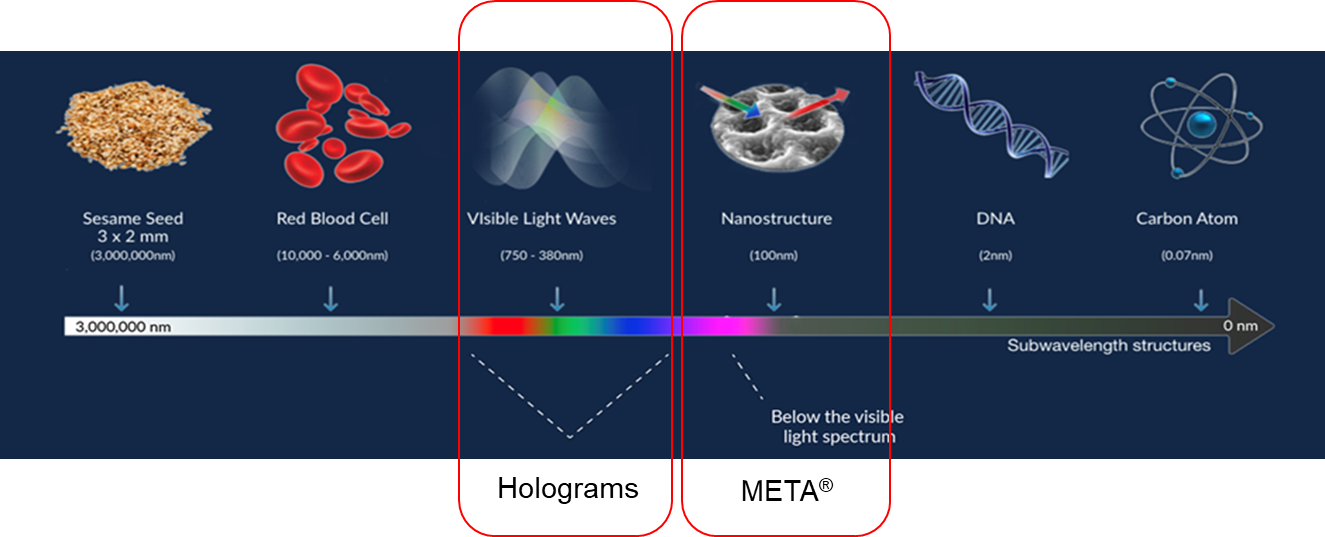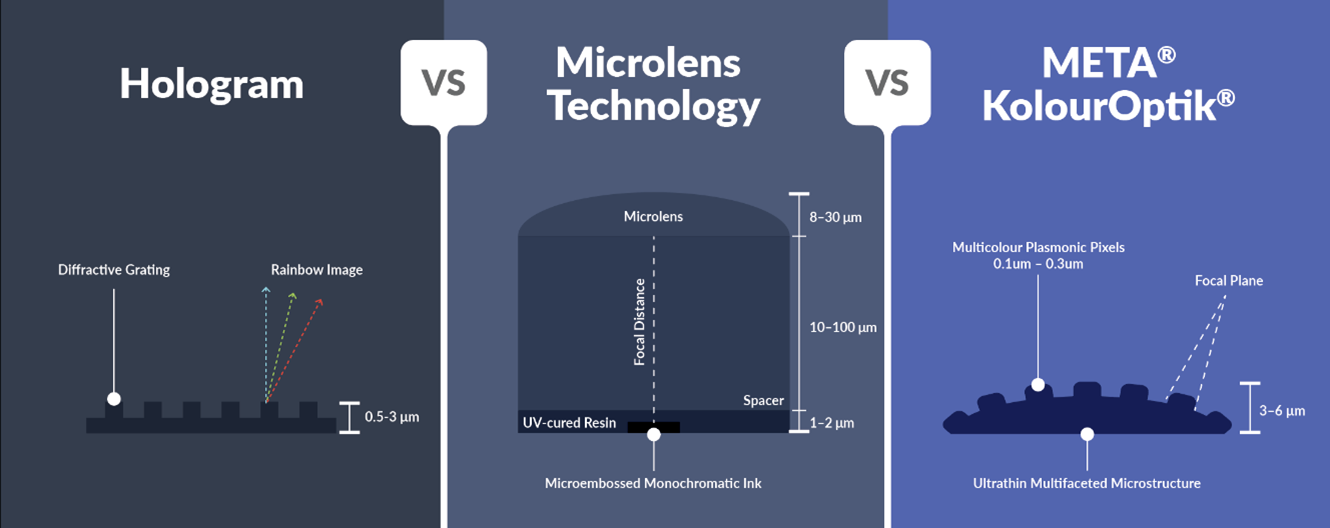The science behind QUANTUM™ stripe's ultra-thin form factor
Banknote security features are an important element that helps central banks protect the public and governments from counterfeiters and counterfeit-related economic losses. Renowned for innovation, Meta Materials Inc. (META) now offers the QUANTUM™ stripe, a fully animated nano-optic banknote security product based on its award-winning KolourOptik® technology.
QUANTUM™ stripe delivers a unique combination of omnidirectional multicolour, 3D stereoscopic depth, and movement effects that are ‘always on’ in an ultrathin form factor. At less than 10 microns (μm) in thickness, QUANTUM™ stripe offers significant advantages over conventional technologies in many aspects, including visibility, user engagement, counterfeit resilience, design freedom, and durability.
Why is being 75% thinner than competing banknote security solutions so important?
.png?width=1500&height=984&name=MicrosoftTeams-image%20(56).png)
Nano-optics vs Microlens Technology
Microlens-based features, a type of Optical Variable Device (OVD), have become increasingly popular due to their ability to create optical effects like 3D depth and animation using Moiré and lenticular effects. These features consist of multiple layers, including a micro-embossed image layer filled with ink, a microlens acting as an image magnifier, separated by a spacer with a matching focal length. Typically, this multilayer stack is thick, ranging from 20 to 130 μm, which exceeds the ideal limit of 10 μm for surface-applied security features on banknotes.
In contrast, nano-optic technology offers a revolutionary approach to optical security features. By leveraging single-layer nanoscale structures and materials, nano-optic products like QUANTUM™ stripe have a thickness of under 10 microns, seamlessly integrating into banknotes without the need for specialized equipment or processes. These nanostructures are meticulously developed in a Class 100 cleanroom environment, using cutting-edge electron-beam lithography (EBL) and proprietary nanofabrication techniques. Nanostructures manipulate light at the nanoscale, resulting in a lens-less, full-parallax, multi-color display which can create even more intricate and precise security elements, such as images that appear to move or float above or below the surface of the feature, when viewed from different angles. The figure below illustrates the amazing nanoscopic scale at which these structures are produced.

Figure 1: Illustration of nano-optic scale
The substantial thickness inherent to microlens-based features poses a significant problem, complicating the stacking, handling, and transporting of banknotes bundles. Additionally, these thick features are prone to delamination, or separation of the microlens component, undermining their durability and potentially enabling counterfeiters to harvest and exploit them.
The multilayer structure of microlens-based devices presents additional drawbacks, with respect to sustainability. These features involve a time-consuming and costly manufacturing process, including multiple casting, embossing, printing, vacuum-coating, lamination, and assembly steps. Additionally, their use of various materials results in a significant environmental impact, far greater than nano-optic materials, which can complicate and/or prevent recycling of the banknote. 
Figure 2: META® KolourOptik® nano-optic technology vs Hologram and Microlens Technology
The ultrathin single-layer design of nano-optics offers a significant advantage over microlens technology by substantially decreasing the risk of delamination, ensuring exceptional durability. The absence of separable layers also makes it extremely difficult for counterfeiters to disassemble and reverse-engineer nano-optic security features, thus establishing a higher standard for banknote security.
Unfortunately, the majority of microlens-based OVDs have a significant limitation: they can only display monochromatic images. The primary method for creating micro images in the embossed layer, which involves ink flood coating and doctor blading, restricts the application of multiple ink colors, severely limiting their visual capabilities and customization.
Alternatively, nano-optic technology delivers precise nanoscale structures to achieve color effects, Plasmonic color derives its hues from the interaction of light with metallic nanoparticles, which can generate vivid and dynamic colors, on a pixel-by-pixel basis. Plasmonic color can be dynamically tuned by changing the size, shape, or material of the nanoparticles, providing a versatile means of producing a wide spectrum of colors within a single design.
Enabling new dimensions of security with QUANTUM™ stripe -
• Multiple effects into a single feature
• Ultrathin, robust, metallized foil form factor
• Compatible with paper, polymer, and hybrid substrates
• Reduces the number of production variables while increasing durability & consistency
• Reduces the quantity and variety of material for more sustainable security features
META is now ready to accept QUANTUM™ stripe orders from industry partners and customers interested in implementing this revolutionary banknote security solution. Central banks and industry partners are welcome to contact us, request samples, schedule in-person meetings at upcoming banknote industry events, or obtain further information. Click here to view technical white papers and learn about the science behind our nano-optic banknote security features.
